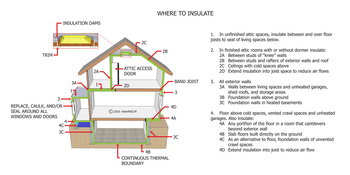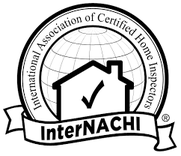Helpful Information
Benefits
|
Are you considering selling your home?
Pre-listing Home Inspections for sellers will offer the opportunity to detect areas of concern and make any desired repairs before listing. Applying our services and making minor repairs may ensure your home is in better selling condition minimizing unexpected delays in the selling process. The professional report may be used as a selling tool to support your asking price. Are you interested in buying a new or pre-owned home? The General Home Inspection provides our clients with information about the overall condition of the home, its systems and components in order to make a more informed purchase decision. Our Thermography inspection may show hidden defects within finished ceiling and walls including moisture intrusion, air infiltration, electrical faults and more. Please understand no home is perfect and the results should not necessarily deter you from the investment. The primary purpose of a home inspection is to assist you in evaluating the homes condition, your budget and expectations. Is the warranty on your home about to expire? Identifying and documenting repairs before the warranty expires may pay for our service by saving you future out of pocket repair costs. Most defects are not extensive or costly repairs when caught early. Skylights, chimneys, flues, vents and roof mounted solar panels are just a few areas likely to allow moisture intrusion if improperly installed, infrared cameras make these issues easily detectable. If left uncorrected and indications become apparent on the surface the repairs and cleanup costs increase significantly. |
"Identifying and documenting repairs before the warranty expires may pay for our service by saving you future out of pocket repair costs." |
Are you having a difficult time regulating the temperature within your home? Would you like to lower your energy bill and reduce your carbon foot print?
According to the U.S. Department of Energy, a home’s energy efficiency is determined by air sealing, insulation, moisture control and ventilation. Air infiltration happens when outside air comes into the home uncontrollably through cracks, gaps, and openings. This allows moldy and dusty air into a leaky home which may lead to problems with moisture control and biological growth. A Thermography Inspection can help pinpoint the possible sources of energy loss, causes of residents discomfort and identify possible safety issues.
According to the U.S. Department of Energy, a home’s energy efficiency is determined by air sealing, insulation, moisture control and ventilation. Air infiltration happens when outside air comes into the home uncontrollably through cracks, gaps, and openings. This allows moldy and dusty air into a leaky home which may lead to problems with moisture control and biological growth. A Thermography Inspection can help pinpoint the possible sources of energy loss, causes of residents discomfort and identify possible safety issues.
Insulation
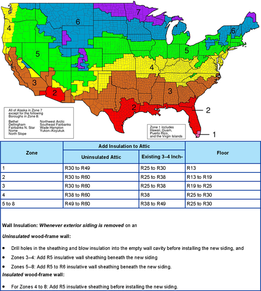
Insulation is your primary defense against heat loss and heat gain through the house envelope. There are several common types of insulation – Fiberglass (in both batt and blown forms), cellulose, rigid board insulation, and spray foam. Reflective insulation (or radiant barrier) can also help save energy in hot, sunny climates. When correctly installed, each type of insulation can deliver comfort and lower energy bills.
To get the biggest savings, the easiest place to add insulation is usually in the attic. The recommended insulation levels for most attics are R-30 (about 10-12 inches, depending on the type of insulation). In the coldest climates, insulating up to R-60 is recommended. Adding insulation to an unheated attic is easier than insulating existing walls and is likely to have a greater impact on comfort and energy use. If there is no floor in the attic, simply add more insulation between the ceiling beams, either loose fill or unfaced fiberglass batts. Because insulation works best when air is not moving through or around it, it is important to seal air leaks before installing insulation to ensure that you get the best performance.
If you have a crawl space, it should be sealed, not ventilated. To do this, use 6-mm thick polyethylene sheeting as a moisture barrier to cover the ground and seal tightly to walls and columns. Then use rigid foam or spray foam to insulate the foundation walls.
To get the biggest savings, the easiest place to add insulation is usually in the attic. The recommended insulation levels for most attics are R-30 (about 10-12 inches, depending on the type of insulation). In the coldest climates, insulating up to R-60 is recommended. Adding insulation to an unheated attic is easier than insulating existing walls and is likely to have a greater impact on comfort and energy use. If there is no floor in the attic, simply add more insulation between the ceiling beams, either loose fill or unfaced fiberglass batts. Because insulation works best when air is not moving through or around it, it is important to seal air leaks before installing insulation to ensure that you get the best performance.
If you have a crawl space, it should be sealed, not ventilated. To do this, use 6-mm thick polyethylene sheeting as a moisture barrier to cover the ground and seal tightly to walls and columns. Then use rigid foam or spray foam to insulate the foundation walls.
Radiant Barriers
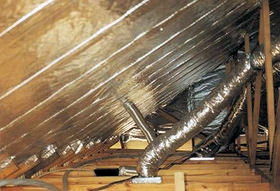
Radiant barriers are most commonly installed in attics to reduce summer heat gain and winter heat loss, which helps lower heating and cooling costs. These barriers consist of a highly reflective material that reflects radiant heat rather than absorbing it. However, they do not reduce heat conduction like thermal insulation materials.
When the sun heats a roof, it's primarily the sun's radiant energy that makes the roof hot. A large portion of this heat travels by conduction through the roofing materials to the attic side of the roof. The hot roof material then radiates its gained heat energy onto the cooler attic surfaces, including the air ducts and the attic floor. A radiant barrier reduces the radiant heat transfer from the underside of the roof to the other surfaces in the attic.
Benefits of Radiant Barrier
When the sun heats a roof, it's primarily the sun's radiant energy that makes the roof hot. A large portion of this heat travels by conduction through the roofing materials to the attic side of the roof. The hot roof material then radiates its gained heat energy onto the cooler attic surfaces, including the air ducts and the attic floor. A radiant barrier reduces the radiant heat transfer from the underside of the roof to the other surfaces in the attic.
Benefits of Radiant Barrier
- Reflects up to 97% of the incoming solar heat gain rather than absorbing it
- Reduces summer heat gain and winter heat loss
- Decreases the ambient air temperature of your attic
- Allows your heating and air system to function more efficiently, which lowers your heating and air costs
Air and Duct Sealing
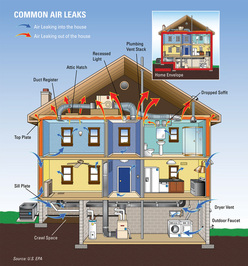
In typical homes, air leaks are often found at cracks, small holes, and penetrations for plumbing, wiring, lighting, and duct work. Together, these leaks can add up to as much air loss as having an open window! It’s easy to imagine how this can increase a homeowner’s utility bills and reduce comfort.
Sealing a home’s envelope—its exterior walls, ceiling, and floors—is an important step in controlling the indoor environment and lowering energy bills. The goal is to reduce air leakage as much as possible, while providing ventilation as needed for fresh air. In other words, “build it tight and ventilate it right.”
Improved Comfort - Drafts felt during the winter are often the result of unsealed cracks and holes. Sealing homes tightly typically results in fewer drafts and less noise.
Lower Utility Bills - Air leakage and improperly installed insulation can waste 20 percent or more of the energy used to heat or cool a home. With effective air sealing and insulation, heating and cooling systems will work more efficiently, ultimately costing less to operate.
Improved Indoor Air Quality - A tighter home envelope reduces the amount of humidity, dust, pollen, and pests that can enter the home helping improve indoor air quality and improving the impact your home has on your personal health.
Increased Durability - When warm air leaks through a home's floors, walls, and attic, it can come in contact with cooler surfaces where condensation can occur. Moisture that occurs in these construction assemblies encourages mold growth, ruins insulation, and even compromises the structural elements of the home. Reducing air leakage helps minimize moisture problems and increases the home's durability.
Sealing a home’s envelope—its exterior walls, ceiling, and floors—is an important step in controlling the indoor environment and lowering energy bills. The goal is to reduce air leakage as much as possible, while providing ventilation as needed for fresh air. In other words, “build it tight and ventilate it right.”
Improved Comfort - Drafts felt during the winter are often the result of unsealed cracks and holes. Sealing homes tightly typically results in fewer drafts and less noise.
Lower Utility Bills - Air leakage and improperly installed insulation can waste 20 percent or more of the energy used to heat or cool a home. With effective air sealing and insulation, heating and cooling systems will work more efficiently, ultimately costing less to operate.
Improved Indoor Air Quality - A tighter home envelope reduces the amount of humidity, dust, pollen, and pests that can enter the home helping improve indoor air quality and improving the impact your home has on your personal health.
Increased Durability - When warm air leaks through a home's floors, walls, and attic, it can come in contact with cooler surfaces where condensation can occur. Moisture that occurs in these construction assemblies encourages mold growth, ruins insulation, and even compromises the structural elements of the home. Reducing air leakage helps minimize moisture problems and increases the home's durability.
Indoor Air Quality (IAQ)

Indoor air pollutants are unwanted, sometimes harmful materials in the air and is among the leading top five environmental health risks. Usually the best way to address this risk is to control or eliminate the sources of pollutants, and to ventilate a home with clean outdoor air. The ventilation method may, however, be limited by weather conditions or undesirable levels of contaminants contained in outdoor air. If these measures are insufficient, an air cleaning device may be useful. Air cleaning devices are intended to remove pollutants from indoor air. Some air cleaning devices are designed to be installed in the duct work of a home’s central heating, ventilating, and air-conditioning (HVAC) system to clean the air in the whole house. Portable room air cleaners can be used to clean the air in a single room or specific areas, but they are not intended for whole-house filtration.
Two types of air cleaning devices can remove particles from the air — mechanical air filters and electronic air cleaners. Mechanical air filters remove particles by capturing them on filter materials. High efficiency particulate air (HEPA) filters are in this category. Electronic air cleaners such as electrostatic precipitators use a process called electrostatic attraction to trap charged particles. They draw air through an ionization section where particles obtain an electrical charge. The charged particles then accumulate on a series of flat plates called a collector that is oppositely charged. Ion generators, or ionizers, disperse charged ions into the air, similar to the electronic air cleaners but without a collector. These ions attach to airborne particles, giving them a charge so that they attach to nearby surfaces such as walls or furniture, or attach to one another and settle faster.
Some air cleaners use ultraviolet (UV) light technology intended to destroy pollutants in indoor air. These air cleaners are called ultraviolet germicidal irradiation (UVGI) cleaners. UVGI cleaners use ultraviolet radiation from UV lamps that may destroy biological pollutants such as viruses, bacteria, allergens, and molds that are airborne or growing on HVAC surfaces (e.g., found on cooling coils, drain pans, or duct work). If used, they should be applied with, but not as a replacement for, filtration systems. Consumers can select a particle removal air filter by looking at its efficiency in removing airborne particles from the air stream that passes through it. This efficiency is measured by the minimum efficiency reporting value (MERV) for air filters installed in the ductwork of HVAC systems.
The American Society of Heating, Refrigerating and Air-Conditioning Engineers, or ASHRAE developed this measurement method. MERV ratings (ranging from a low of 1 to a high of 20) also allow comparison of air filters made by different companies. Higher efficiency filters with a MERV of 14 to 16, sometimes misidentified as HEPA filters, are similar in appearance to true HEPA filters, which have MERV values of 17 to 20. True HEPA filters are normally not installed in residential HVAC systems; installation of a HEPA filter in an existing HVAC system would probably require professional modification of the system. A typical residential air handling unit and the associated duct work would not be able to accommodate such filters because of their physical dimensions and increase in airflow resistance. Some residential HVAC systems may not have enough fan or motor capacity to accommodate higher efficiency filters. Therefore, the HVAC manufacturer’s information should be checked prior to upgrading filters to determine whether it is feasible to use more efficient filters. Specially built high performance homes may occasionally be equipped with true HEPA filters installed in a properly designed HVAC system.
Two types of air cleaning devices can remove particles from the air — mechanical air filters and electronic air cleaners. Mechanical air filters remove particles by capturing them on filter materials. High efficiency particulate air (HEPA) filters are in this category. Electronic air cleaners such as electrostatic precipitators use a process called electrostatic attraction to trap charged particles. They draw air through an ionization section where particles obtain an electrical charge. The charged particles then accumulate on a series of flat plates called a collector that is oppositely charged. Ion generators, or ionizers, disperse charged ions into the air, similar to the electronic air cleaners but without a collector. These ions attach to airborne particles, giving them a charge so that they attach to nearby surfaces such as walls or furniture, or attach to one another and settle faster.
Some air cleaners use ultraviolet (UV) light technology intended to destroy pollutants in indoor air. These air cleaners are called ultraviolet germicidal irradiation (UVGI) cleaners. UVGI cleaners use ultraviolet radiation from UV lamps that may destroy biological pollutants such as viruses, bacteria, allergens, and molds that are airborne or growing on HVAC surfaces (e.g., found on cooling coils, drain pans, or duct work). If used, they should be applied with, but not as a replacement for, filtration systems. Consumers can select a particle removal air filter by looking at its efficiency in removing airborne particles from the air stream that passes through it. This efficiency is measured by the minimum efficiency reporting value (MERV) for air filters installed in the ductwork of HVAC systems.
The American Society of Heating, Refrigerating and Air-Conditioning Engineers, or ASHRAE developed this measurement method. MERV ratings (ranging from a low of 1 to a high of 20) also allow comparison of air filters made by different companies. Higher efficiency filters with a MERV of 14 to 16, sometimes misidentified as HEPA filters, are similar in appearance to true HEPA filters, which have MERV values of 17 to 20. True HEPA filters are normally not installed in residential HVAC systems; installation of a HEPA filter in an existing HVAC system would probably require professional modification of the system. A typical residential air handling unit and the associated duct work would not be able to accommodate such filters because of their physical dimensions and increase in airflow resistance. Some residential HVAC systems may not have enough fan or motor capacity to accommodate higher efficiency filters. Therefore, the HVAC manufacturer’s information should be checked prior to upgrading filters to determine whether it is feasible to use more efficient filters. Specially built high performance homes may occasionally be equipped with true HEPA filters installed in a properly designed HVAC system.

